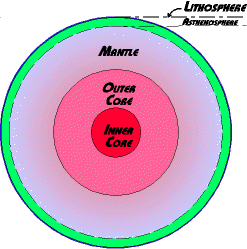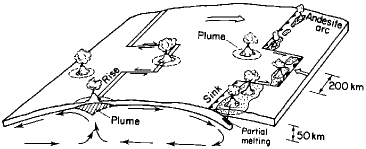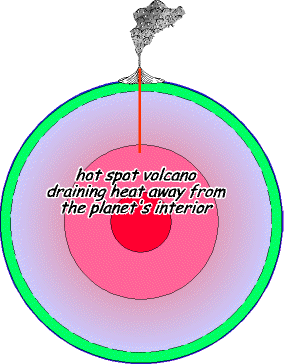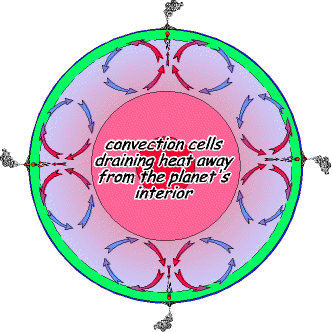THE HEAT HISTORY OF THE EARTH
The earth is a heat engine. It remains geologically and biologically active, and evolves, because there are two great sources of energy. One source of energy is from the earth's molten core (that drives the geology), and the second is from the sun (that drives life and the atmosphere.)However, considering the fact that the solar system began as a cloud of gas and dust that was near absolute zero we might wonder where the earth's internal heat came from to drive the plate tectonics. The problem is more perplexing when we realize that virtually every other planetary body in the solar system (including some moons that are larger than some planets) is geologically dead (they have no internal heat of their own). Similarly, the earth is the only planetary body we know at present that is biologically alive too.
Thus, we wonder, must a planet be geologically alive to also be biologically alive? The short answer is, yes! But that is another story.
Origin of the Concentric Layering
 The earth grew from the accumulation of planetismals (meteorites and asteroids), over a period of 1-200 million years about 4.3 to about 4.5 billion years ago. Toward the end of the accumulation a large mini-planet hit a glancing blow with the earth. If the mini-planet had hit directly the earth would have been shattered, and the debris scattered throughout the solar system - no earth (gee, are there not movies on just this theme? Deep Impact comes to mind). As it was, the mini-planet hit obliquely, and then spun off into an orbit around the earth - to become the moon.
The earth grew from the accumulation of planetismals (meteorites and asteroids), over a period of 1-200 million years about 4.3 to about 4.5 billion years ago. Toward the end of the accumulation a large mini-planet hit a glancing blow with the earth. If the mini-planet had hit directly the earth would have been shattered, and the debris scattered throughout the solar system - no earth (gee, are there not movies on just this theme? Deep Impact comes to mind). As it was, the mini-planet hit obliquely, and then spun off into an orbit around the earth - to become the moon.If the earth had grown simply from the random accumulation of planetismals it would have been homogeneous - more or less made of the same material throughout, and the earth cross section to the right would be a uniform blob with no structure.
But the earth is stratified into layers by density (heavy core, intermediate mantle, light lithosphere), telling us that early in its history the earth went through a molten stage that led to the heavy materials sinking inward to form the core, and the lighter materials floating toward the surface like a slag to form the crust. The heat for this melting came from meteorite impacts, the moon's impact, and the decay of radioactive elements.
Imagine flying by the earth in a space ship about 4.3 billion years ago; all you would see is a glowing red hot ball of seething magma.
All of the geological activity on the earth today is driven from this initial source of heat at the earth's formation, aided and abetted by continued radioactive decay of elements in the earth's interior. However, the earth's heat engine ran faster at the beginning than now, about three times faster. Considering how active the earth is now with earthquakes and volcanoes it must have been a wonder four billion years ago to have it running even faster. But the earth is cooling off, and as time goes by there will be less and less heat to escape until there is none left at all. At that point the earth will die a heat death.
Different planets can have different histories, however, and we can get some idea of how unique the earth is by examining these histories.
Cooling History of Planetary Bodies
 By 4 billion years ago the earth had cooled enough for the outer layers to have solidified and for oceans to form. Flying past the earth at this time we would see a vast ocean from pole to pole, with volcanoes scattered here and there but no continents - pretty much the scene to the right captured about about 3.8-4.0 billion years ago. The oldest rocks we have date to 3.96 billion years ago, and contain evidence of sedimentary rocks that require water.
By 4 billion years ago the earth had cooled enough for the outer layers to have solidified and for oceans to form. Flying past the earth at this time we would see a vast ocean from pole to pole, with volcanoes scattered here and there but no continents - pretty much the scene to the right captured about about 3.8-4.0 billion years ago. The oldest rocks we have date to 3.96 billion years ago, and contain evidence of sedimentary rocks that require water.The earth cooled from the outside in, and the still molten iron-nickle core are the remnants of that heat from the early stage of melting. That heat is also what keeps the earth geologically active, and without it nothing that we know of the earth would exist today, no continents, no volcanos, no mountains, no oceans, and almost certainly no life - a dead planet like mars or the moon.
There are several ways a planetary body can loose its internal heat. One way occurs with small planetary bodies, such as the moon. Here we see a planetary body that became geologically dead within a few hundred thousand years after its formation. We know this because the original craters from its formation are still present.
 With the moon the heat escaped by two mechanisms. One was volcanic activity induced by meteorite impacts. The meteorites penetrated through the crust and into the core, and provided a conduit for magma to reach the surface and form the mare (smooth areas) we see from earth. This magma brought much heat to the surface to radiate to space. The second way heat escaped was through condution. Rock is a poor conductor of heat, however, so in larger planetary bodies most of the heat must escape by other means.
With the moon the heat escaped by two mechanisms. One was volcanic activity induced by meteorite impacts. The meteorites penetrated through the crust and into the core, and provided a conduit for magma to reach the surface and form the mare (smooth areas) we see from earth. This magma brought much heat to the surface to radiate to space. The second way heat escaped was through condution. Rock is a poor conductor of heat, however, so in larger planetary bodies most of the heat must escape by other means.Mars is an example of another way internal heat can be lost. Olympus mons, the large Martian volcano is a hot spot, and it probably tapped directly into the core of the planet, and piped the heat in the form of magma directly to the surface. Hot spots are typically huge volcanos, and Olympus mons is much bigger than any on earth. So here the heat escaped relatively quickly, leading to the planet becomes geologically dead shortly after formation. It helps that Mars is less than half the size of the earth.
 The third way a planet can lose its heat is to establish convection cells in the mantle. That is, hot, low density material from the lower mantle, heated by the core, flows upward towards the surface where the heat escapes through volcanic activity. The cooled, now denser material then sinks back toward the core to be heated again. This creates a cycle of movement, but it is very slow, only centimeters per year, taking on the order of a billion years of so for a complete cycle.
The third way a planet can lose its heat is to establish convection cells in the mantle. That is, hot, low density material from the lower mantle, heated by the core, flows upward towards the surface where the heat escapes through volcanic activity. The cooled, now denser material then sinks back toward the core to be heated again. This creates a cycle of movement, but it is very slow, only centimeters per year, taking on the order of a billion years of so for a complete cycle.Typically many convection cells exist simultaneously all over the planet, and they lead to widely scattered volcanic activity, and plate tectonic processes.
Some measure of the time involved for a planet the size of the earth to cool by convection is that the earth has been geologically active for over 4 billion years, and will probably take another 4-5 billion years to loose all its heat -and become a dead planet. Just think, no earthquakes, no volcanos, no tidal waves - the earth will sink into a deep, cold sleep - except for the fact that by that time the sun will expand into its red giant phase and burn the earth to a crisp before that final heat death comes.
Go On To: